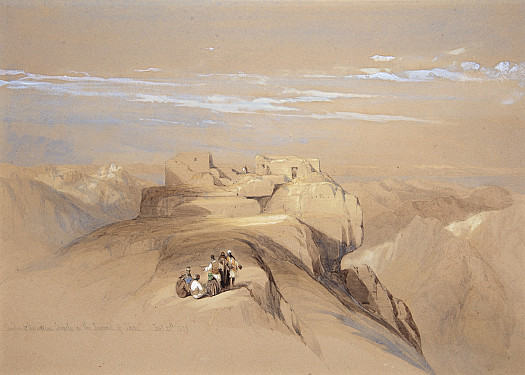David Roberts was born in Stockbridge, near Edinburgh, on 24 October 1796, the eldest child of a shoemaker and a laundress. Even before his rudimentary schooling, he had exhibited a love of images and a talent for drawing. As a result, he was apprenticed from the age of ten to Gavin Beugo, an Edinburgh house-painter.
During the next seven years, he developed many skills and, on the completion of his apprenticeship, assisted on the decoration of Scone Palace, Perthshire. Following his return to Edinburgh, he met James Bannister and, in 1816, joined his new touring ‘company of pantomimists’, mainly though not exclusively as a scene-painter. During the following year, the company travelled to Carlisle, Newcastle, Hull and York, an experience that enabled him to make drawings of landscape and architecture. Once back inScotland, he returned mainly to house-painting, until the opportunity arose to paint scenery at The Pantheon, Edinburgh (1818-19), the Theatre Royal, Glasgow (1819-20), and the Theatre Royal, Edinburgh. In Glasgow he married, while at the Theatre Royal, Edinburgh, he met and befriended the marine painter, Clarkson Stanfield, who encouraged him to exhibit works at the Fine Arts Institution.
In 1823, Roberts moved to London, and worked at the Theatre Royal, Drury Lane, in a position subordinate to Clarkson Stanfield and Gaetano Marinari. He soon turned more seriously to easel painting, and began to exhibit more regularly, being encouraged by the foundation, in the same year, of the Society of British Artists. (Eventually becoming its president in 1831, he resigned from the society in 1835 in the hope of being admitted to the Royal Academy of Arts.) He showed mainly at the British Institution (1824-59) and the Royal Academy (1826-64), his first exhibit at the RA being a version of his painting of Rouen Cathedral, the result of his initial trip abroad, to Normandy in 1824. (He would become an Associate of the RA in 1838, and a Royal Academician in 1841.) Through the late 1820s, while he was still painting scenery, at Covent Garden, his exhibited pictures were divided between French, Belgian and Scottish subjects. Germany was added following his Rhine journey in 1830.
On the recommendation of his fellow Scots painter, John Wilkie, Roberts visited Spain, and Tangier, on his first extended foreign tour, in the years 1832-33. The sketches that he made became the basis of many oils and watercolours, and then of prints, including the engravings that appeared in Jennings’ Landscape Annual (1835-38) and the lithographs comprising Picturesque Sketches in Spain during the Years 1832 and 1833 (1837).
The success of such work led Roberts to receive many commissions as a topographical illustrator, including one for T H Horne’s Landscape Illustrations of the Bible (1836), for which he developed the sketches made on the spot by other artists (as exemplified by the present watercolour). As Briony Llewellyn explains, ‘These encounters with the oriental world ... encouraged him to undertake a tour of the Near East in 1838. He was one of the first independent and professional British artists to experience the Orient at first hand’ (Llewellyn 1996, page 463). During a tour lasting two years, he visited Egypt, the Holy Land and Syria, in order to study the major monumental ancient sites, notably those with biblical associations, and also record much of the contemporary picturesque detail. The resulting sketches provided material for a decade, and culminated in Views in the Holy Land, Syria, Idumea, Arabia, Egypt and Nubia, a collection of 247 lithographs that were eventually published in six volumes in the years 1842-49. Long considered an invaluable source for topographical information on the Orient, these volumes earned him an international reputation. They also confirmed a clear change in his art, from the strong, luminous palette derived from eighteenth century Dutch masters to one that was less vivid.
While returning to France and the Low Countries through the 1840s, Roberts turned his attention to Italy during the following decade. He toured the northern states, as well as Austria, in 1851, and extended his experience to Rome and Naples in 1853-54. As a result, Italian subjects began to dominate his work. Then, in 1860, despite ill health, he began a ‘serries of Pictures of London from the River Thames’, in a much darker palette, an ambitious project that remained unfinished at the time of his death. He died at 38 Fitzroy Street, his home since 1839, on 25 November 1864. His wife, from whom he had separated, had died four years earlier, but he remained devoted to his daughter. His studio sale was held at Christie’s, on 13 and 15-19 May 1865, while a further sale of his estate took place on 7 April 1881.
His work is represented in Government Art Collection and the Royal Collection and numerous public collections, including the British Museum, Guildhall Art Gallery, Tate and the V&A; The Fitzwilliam Museum (Cambridge), Manchester Art Gallery, Museums Sheffield and the Walker Art Gallery (Liverpool); Aberdeen Art Gallery & Museums and the National Gallery of Scotland (Edinburgh); and Yale Center for British Art (New Haven, CT).
Further reading:
James Ballantine, The Life of David Roberts RA, Edinburgh: Adam and Charles Black, 1866; Helen Guiterman, David Roberts, RA, 1796–1864, London, privately printed, 1986 (revised edition); Helen Guiterman and Briony Llewellyn (eds), David Roberts RA 1796-1864, Oxford Phaidon/London: Barbican Art Gallery, 1986; Martin Hardie, ‘David Roberts, R.A., 1796-1864’, The Old Water-Colour Society’s Club, vol 25, 1947, pages 10-20; Briony Llewellyn, ‘Roberts, David
(b Stockbridge, nr Edinburgh, 24 Oct 1796; d London, 25 Nov 1864)’, Jane Turner (ed), The Dictionary of Art, London: Macmillan, 1996, vol 26, pages 463-464; Krystyna Matyjaszkiewicz, ‘Roberts, David (1796-1864)’, H C G Matthew and Brian Harrison (eds), Oxford Dictionary of National Biography, Oxford University Press, 2004, vol 47, pages 146-149


